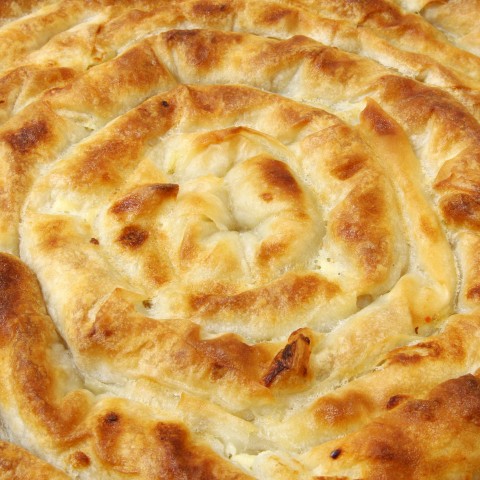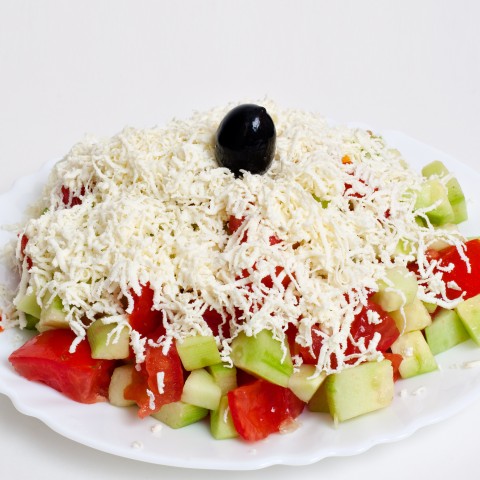
To truly learn a foreign language, you must also become familiar with that country’s culture. And its national cuisine is a great place to start!
Traditional Bulgarian food offers a glimpse of the country’s cultural background and will help you learn more about the people there. As a language learner, you’ll benefit from exploring Bulgarian cuisine and tasting many of the traditional dishes yourself.
Today, BulgarianPod101 will lead you through the sweetest part of language learning. We’ll introduce you to the best Bulgarian foods, go over some essential food-related vocabulary, and even give you a couple of simple Bulgarian recipes you can make at home.
Let’s begin our delicious journey into Bulgarian cuisine!
 Table of Contents
Table of Contents
- Five Must-Try Dishes in Bulgarian Restaurants
- Authentic Bulgarian Food vs. Overseas Food
- Unique Bulgarian Foods
- Food-Related Vocabulary
- Bonus: Simple Recipes to Make Authentic Bulgarian Food at Home
- Final Thoughts

1. Five Must-Try Dishes in Bulgarian Restaurants
If you’re planning a trip to Bulgaria, the most important consideration—after your accommodation and sightseeing agenda—is what you’ll eat during your visit. To help you make the most of your stay in Bulgaria, we’ll start with a list of traditional Bulgarian food you must try while you’re here.
Banitsa
The Bulgarian food banitsa is one of the most popular traditional dishes. Its ingredients include eggs, Bulgarian cheese, Bulgarian yogurt, and “filo dough,” or кори за баница (kori za batnitsa). Filo dough refers to very thin sheets of pastry, which are used specifically for preparing banitsa. You can find them at any Bulgarian food market.
There are many types of banitsa, differing in the arrangement of the filo dough as well as the fillings used. Besides the yogurt, cheese, and eggs, one could also add spinach, leek, or even minced meat.
One thing is for sure: You need to try banitsa! We guarantee you’ll fall in love with it, especially if you have the chance to taste a homemade one.

Banitsa is often eaten as a breakfast item with one of the following drinks:
- айрян (ayrian), which is a Turkish beverage made of yogurt, water, and salt. You can easily prepare this beverage at home with the recipe at the end of this article.

- боза (boza), which is an unfermented or lightly fermented beverage prepared by boiling cereal porridge and then diluting it with water. People also add sugar to make it sweet.

Tarator
This is a very popular cold Bulgarian summer soup, so no boiling is needed! It’s made of yogurt, water, finely chopped or grated cucumbers, chopped walnuts, and some spices like salt and dill.
The good news is that tarator is so simple and convenient to prepare. You can make it yourself in just ten to twenty minutes using the recipe at the end of this article. But if you’re having lunch in a Bulgarian restaurant during a hot summer day, you can order tarator made with organic ingredients for a refreshing meal.

Shopska Salata
Шопска салата (Shopska salata) is a Bulgarian salad made with chopped tomatoes, cucumbers, roasted peppers, onions, fresh parsley, and grated white cheese. It tastes wonderful with a dressing of olive oil and vinegar. This salad makes a perfect side dish to tarator, so your vegetarian lunch in a restaurant could consist of tarator and shopska salata.
Bulgarians love to drink rakiya, a traditional strong alcoholic beverage, with this salad.

Patatnik
As the name suggests, the main ingredient of patatnik is potatoes. This is a delicious dish that’s commonly prepared by people who live in the Rhodope Mountains, and its recipe is transferred from generation to generation.
Patatnik is made from grated potatoes, onions, cheese, eggs, and sometimes meat. These ingredients are baked in the oven at a low temperature for the perfect taste and texture.
This is a must-try Bulgarian dish that makes a great dinner in any season!
Gyuvech
Гювеч (gyuvech) is a traditional Bulgarian dish that’s prepared in a refractory clay pot with a clay lid, also called gyuvech in Bulgarian. It’s prepared with different vegetables, such as potatoes, cabbage, tomatoes, eggplants, carrots, and onions, and meat can also be added.
This traditional Bulgarian food is worth trying because of its unique taste, achieved through cooking slowly in the clay pot. It’s a great lunch or dinner item in Bulgarian restaurants.

2. Authentic Bulgarian Food vs. Overseas Food
Bread is a staple of authentic Bulgarian cuisine, present at the table for every meal. The nation’s history and culture play a huge role in this phenomenon. Even centuries ago, Bulgarians ate a lot of bread while under the Turkish yoke; during the years of hunger after the World Wars, many people ate хляб и лук (hlyab i luk), or “bread and onion.”

Over the past few decades, foreign restaurants have introduced Bulgarians to cuisines from many other cultures: Italian, Chinese, Japanese, Moroccan, and the list goes on. In particular, restaurants offering Mediterranean cuisine have become more and more popular because of their tasty and healthy food.
But there are still some popular international dishes that are unfamiliar to Bulgarians, which means you’re unlikely to find them in restaurants during your visit. For example, if you were to ask a Bulgarian about gingerbread, goulash, or pot-au-feu, they probably wouldn’t have heard of them. These foods just aren’t typical for Bulgarian culture.
3. Unique Bulgarian Foods
Now, let’s take a closer look at some unique Bulgarian food classics that can really only be found in-country. You’ve probably heard of these already, so don’t miss out on tasting them during your visit.
Bulgarian Yogurt
Bulgarian yogurt is milk that’s been fermented with the microorganisms Lactobacillus bulgaricus and Streptococcus thermophilus. These two bacteria are in a symbiotic relationship that produces Bulgarian кисело мляко (kiselo mlyako), which is famous for its health benefits and slightly sour (yet pleasant) taste.
Unfortunately, these bacteria cannot survive naturally on other places on earth, which makes this Bulgarian milk product unique.

Bulgarian Strawberry Jam
One of the most popular and delicious jams made in Bulgaria is сладко от ягоди (sladko ot yagodi), or strawberry jam made from whole fruit wild strawberries. Our strawberry jam has no artificial ingredients, colorants, or preservatives—not to mention it tastes fantastic! Bulgarians usually eat this jam with палачинки (palachinki), or “pancakes,” for breakfast.

Bulgarian Lyutenitsa
Another unique Bulgarian food to try is definitely лютеница (lyutenitsa). This is a chutney made of roasted vegetables (tomatoes, eggplants, and peppers) and seasoned with spices. The vegetables are made into a thick paste with a rich red color and an amazing flavor. Bulgarians love lyutenitsa, and they usually eat it on a slice of bread with white cheese.

Kozunak – Easter Bread
It’s impossible to celebrate Easter in Bulgaria without this Bulgarian Easter food called козунак (kozunak) on the festive table. This sweet bread is traditionally made on the Saturday morning just before Easter, and no one is allowed to eat it before Sunday. If you happen to visit Bulgaria during the Easter celebrations, don’t miss out on trying this special bread, which typically contains raisins and Turkish delight.

4. Food-Related Vocabulary
Now that you’re good and hungry for traditional Bulgarian cuisine, let’s go over some useful food-related words and phrases! We’ll start with a brief review of all the dishes we’ve already mentioned.
- баница (banitsa) – cheese pastry
- кори за баница (kori za banitsa) – filo dough
- айрян (ayrian) – beverage made of yogurt and water
- боза (boza) – sweet fermented grain beverage
- таратор (tarator) – a cold Bulgarian summer soup made of yogurt and cucumbers
- шопска салата (shopska salata) – Bulgarian salad
- ракия (rakiya) – traditional strong alcoholic beverage
- пататник (patatnik) – traditional Rhodope Mountain dish made of potatoes
- гювеч (gyuvech) – traditional Bulgarian dish made in a refractory clay pot
- хляб (hlyab) – bread
- лук (luk) – onion
- кисело мляко (kiselo mlyako) – Bulgarian yogurt
- сладко от ягоди (sladko ot yagodi) – strawberry jam
- палачинки (palachinki) – pancakes
- лютеница (lyutenitsa) – a thick paste made of roasted vegetables
- козунак (kozunak) – sweet Easter bread
What’s your favorite Bulgarian food? Learn its name on our free vocabulary list!
Now, let’s suppose that you’re in a Bulgarian restaurant. Here are a few practical words and phrases you can use with your waiter.

- келнер (kelner) – waiter
- Менюто, моля! (menyuto, molya!) – The menu, please.
- Пържени яйца (parzheni yaitsa) – fried eggs
- Варени яйца (vareni yaitsa) – boiled eggs
- Пица (pitsa) – pizza
- Пържени картофи (parzheni kartofi) – french fries
- Кашкавал пане (kashkaval pane) – fried breaded yellow cheese
- Запеканка (zapekanka) – casserole
- Какво ще ми препоръчате за основно ястие? (Kakvo shte mi preporachate za osnovno yastie?) – What would you recommend for a main course?
- Какво предлагате за пиене? (Kakvo predlagate za piene?) – What do you offer to drink?
- Какви видове супи имате? (Kakvi vidove supi imate?) – What types of soups do you have?
- Какво предлагате за десерт? (Kakvo predlagate za desert?) – What do you offer for dessert?
If you would like to learn some more useful phrases you could use in a restaurant, BulgarianPod101 offers a list of the most Useful Phrases for Ordering Food.
5. Bonus: Simple Recipes to Make Authentic Bulgarian Food at Home
If you like to cook, you might enjoy making some traditional Bulgarian dishes. You could certainly impress your family, friends, or guests with your Bulgarian cooking! Here are three easy-to-follow Bulgarian food recipes you can try.
How to Make Mekitsi
Mekitsi, also known in English as Bulgarian Fried Dough, is one of the favorite breakfast foods among Bulgarians—both young and old!

The recipe is easy to follow and you’ll definitely want to make these fried mekitsi again and again after you try them once.
Ingredients:
- 1⁄4 cup of warm water
- 1⁄2 teaspoon of dry yeast
- 1 egg
- about 2 cups of flour
- 1⁄2 cup of yogurt
- a pinch of salt
- oil (for frying)
Instructions:
1. Dilute the dry yeast in the warm water. To help it activate faster, you can also add a pinch of sugar to the water.
2. Then, add the yogurt and egg to the water and stir the mixture well. Now add the salt and flour, and mix. Make sure your dough is soft and not too thick. Then, let it stay for an hour.
3. After that period, it’s ready for frying. Heat the oil in a pot. Meanwhile, roll the dough into circles. Once the oil is heated, drop them in the pot. When they turn golden in color, turn them over to fry the other side.
4. When ready, mekitsi are usually sprinkled with powdered sugar. Bon appetit!
How to Make Tarator
This simple Bulgarian cold soup will take a maximum of twenty minutes to prepare.
Ingredients:
- 500g of Bulgarian yogurt (kiselo mlyako)
- 2 cucumbers
- 500g of water
- 2 tablespoons of crushed walnuts
- 3 garlic cloves
- Olive oil
- Salt
- Dill
Instructions:
1. Cut the cucumbers into tiny cubes or use a grater to grate them.
2. Beat the yogurt to give it an even consistency and add it together with the cucumbers, crushed garlic, and walnuts in a big bowl. The dill is an obligatory spice for this soup, so add a generous amount of it. Add salt and olive oil to taste, add the water, and stir.
3. Your tarator is ready. If you would like to chill it, you can add a few ice cubes or put it in the refrigerator for thirty minutes.
How to Make Ayran
This beverage is quite popular in Bulgaria, especially during the hot summer days. To make it, you need only three ingredients.
Ingredients:
- 1 cup of Bulgarian yogurt (kiselo mlyako)
- 1 cup of water
- Salt to taste
Instructions:
Just mix all the ingredients together using your blender (or you can stir them together by hand). Your cool summer beverage is ready!
6. Final Thoughts
We hope you enjoyed our little guide to Bulgarian meals and other popular food items! Which of these Bulgarian foods would you most like to try? Have you already tried any of them?
Are you new here? BulgarianPod101 is a Bulgarian language learning platform where you can learn Bulgarian in a different and innovative way. We offer tons of fun and effective lessons for learners at every level, as well as free vocabulary lists and other learning resources. We hope to see you around!













